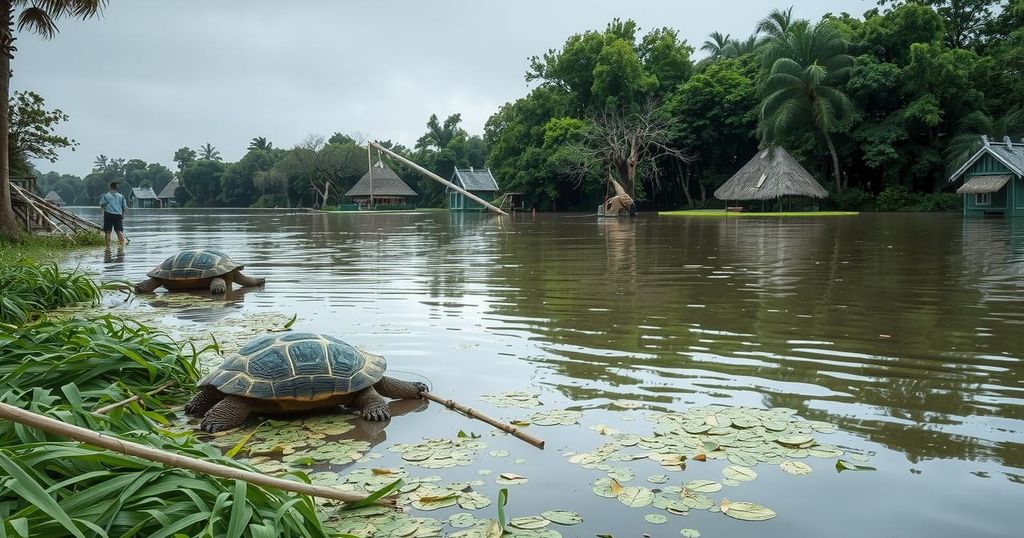World news
AFRICA, ANDREFANA, CLIMATE CHANGE, DI, FLOODING, HERY RAZAFIMAMONJIRAIBE, JORDAN GRAY, LAVAVOLA, LAVAVOLA TORTOISE CENTER, MADAGASCAR, MONGABAY, NATURAL DISASTER, NATURAL DISASTERS, RA, RAZAFIMAMONJIRAIBE, TURTLE SURVIVAL ALLIANCE, TURTLE SURVIVAL ALLIANCE MADAGASCAR
Daniel O'Connor
0 Comments
Severe Flooding Devastates Tortoise Sanctuary in Madagascar
Severe flooding in Madagascar caused by Tropical Cyclone Dikeledi has resulted in the death of 450 tortoises at the Lavavola Tortoise Center, which houses over 12,000 endangered tortoises. The region faced extreme rainfall leading to unprecedented flooding conditions. Though rescue efforts have moved surviving tortoises to elevated enclosures, health risks remain due to ongoing exposure to floodwaters. Volunteers are aiding in recovery, yet the situation highlights the ongoing threats to tortoise populations.
Severe flooding caused by Tropical Cyclone Dikeledi has led to the death of hundreds of tortoises at the Lavavola Tortoise Center in southwestern Madagascar. The cyclone struck on January 16, unleashing torrential rains that inundated the sanctuary, where over 12,000 critically endangered tortoises reside. Approximately 450 radiated and spider tortoises have been found dead, as their habitats were submerged under floodwaters reaching 1.4 meters (4.6 feet).
Despite the rescue efforts, many tortoises faced peril as some were unable to float and became trapped by rocks or swept away by rapid currents. Hery Razafimamonjiraibe, director of Turtle Survival Alliance Madagascar, described the flooding as unprecedented, emphasizing the extremely short duration of the rainfall that precipitated such extensive flooding. The region had previously endured prolonged drought, which worsened the soil’s ability to absorb heavy rains.
To safeguard the remaining tortoises from pneumonia, staff and volunteers have relocated them to elevated enclosures, yet prolonged exposure to the cold waters poses significant health risks. While floodwaters are receding, the main access road to the Lavavola Center remains submerged, hindering transportation for necessary supplies and personnel. Moreover, the homes of several staff members have experienced severe damage from the floods.
Community volunteers have stepped in to assist, contributing over two metric tons of food for the rescued tortoises. Once abundant, the radiated tortoise population has drastically declined due to poaching and trafficking. Meanwhile, Tropical Cyclone Dikeledi, prior to affecting Madagascar, impacted northern Mozambique, resulting in fatalities and displacing thousands of individuals.
The Lavavola Tortoise Center plays a crucial role in the conservation of critically endangered tortoise species, notably the radiated tortoise and spider tortoise. The center houses over 12,000 tortoises, serving as a sanctuary following significant declines in their populations due to illegal wildlife trafficking and habitat destruction. Climate events such as Tropical Cyclone Dikeledi have devastating effects on wildlife sanctuaries, compounding existing challenges faced in conservation efforts.
The catastrophic flooding due to Tropical Cyclone Dikeledi has severely impacted the Lavavola Tortoise Center, resulting in significant tortoise fatalities and ongoing logistical challenges. The resilience of the Madagascar community, however, is showcased through their volunteer efforts in aiding the surviving tortoises. The ongoing threat of poaching and habitat destruction continues to undermine population recovery for the endangered tortoise species. This incident underscores the vulnerability of wildlife sanctuaries to extreme weather events, emphasizing the need for increased conservation and disaster preparedness.
Original Source: news.mongabay.com




Post Comment